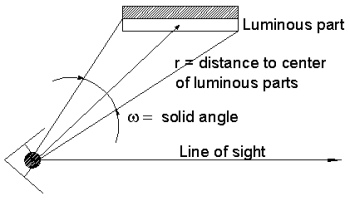
![]()
Calculations UGR Concepts
The Unified Glare Rating calculations available in AGi32 are calculated in accordance with the CIE document CIE 117-1995 - Discomfort Glare in Interior Lighting. The shielding effect of the observer's eyebrows and forehead are considered in this calculation. The CIE definition of Discomfort Glare is "glare that causes discomfort without necessarily impairing the vision of objects". Glare which impairs the vision of objects is termed Disability Glare and is not covered in this metric.
UGR values generally range from 10 to 30 where a high value indicates significant discomfort glare, and a low value indicates little discomfort glare. Electric lighting systems producing UGR values of 10 or less are assumed to produce no discomfort. In AGi32, all calculated UGR values of less than 10 are rounded to 10.
UGR Formula
|
where Lb
is the background luminance (cd/m2); |
|
UGR Limitations
- There is insufficient research to indicate whether the UGR calculations can be applied for indirect lighting or luminous ceilings.
- Sources used within the UGR system should be limited between 0.0003 steradians and 0.1 steradian. This corresponds to luminaires ranging in size from an incandescent downlight seen at 10 meters away to a 1 meter square luminaire seen from 3 meters away.
- UGR is not valid (cannot be calculated) for point sources (luminous dimensions = 0 ,0, 0).
- UGR is only calculated for electric lighting sources, not daylighting.
- AGi32 will calculate UGR for any electric lighting application. It is up to the user to understand the UGR limitations and applicability of UGR.
UGR and Discomfort Glare Criteria
One UGR unit represents the least detectable step in discomfort glare evaluation, and three UGR units represent an acceptability step in glare criteria. Average UGR value range from 10-13-16-19-22-25-28. The relationship between calculated UGR value and Hopkinson's discomfort glare criteria is as follows:
|
UGR |
Discomfort Glare Criterion |
|---|---|
|
10 |
Imperceptible |
|
13 |
Just perceptible |
|
16 |
Perceptible |
|
19 |
Just acceptable |
|
22 |
Unacceptable |
|
25 |
Just uncomfortable |
|
28 |
Uncomfortable |
Correlated UGR and VCP Values
Visual Comfort Probability (VCP) is a measure of discomfort glare for interior lighting applications. According to the IES Handbook, 9th Edition, page 9-26: "The visual comfort probability (VCP) is the probability that a normal observer does not experience discomfort when viewing a lighting system under defined conditions. ... This system was tested and validated using lensed direct fluorescent systems only. VCP should not be applied to very small sources such as incandescent and high-intensity discharge luminaires, to very large sources such as ceiling and indirect systems, or to non-uniform sources such as parabolic reflectors." With these caveats in mind, UGR can be correlated with VCP for lighting systems that consist of luminaires that fall within the scope of the definition of VCP. The following table shows this correlation.
|
UGR |
VCP Equivalent |
|---|---|
|
11.6 |
90% |
|
16 |
80% |
|
19 |
70% |
|
21.6 |
60% |
|
24 |
50% |

